Affiliate links on Android Authority may earn us a commission. Learn more.
Google Pixel 6 vs Samsung Galaxy S21: Which phone should you buy?
April 12, 2022
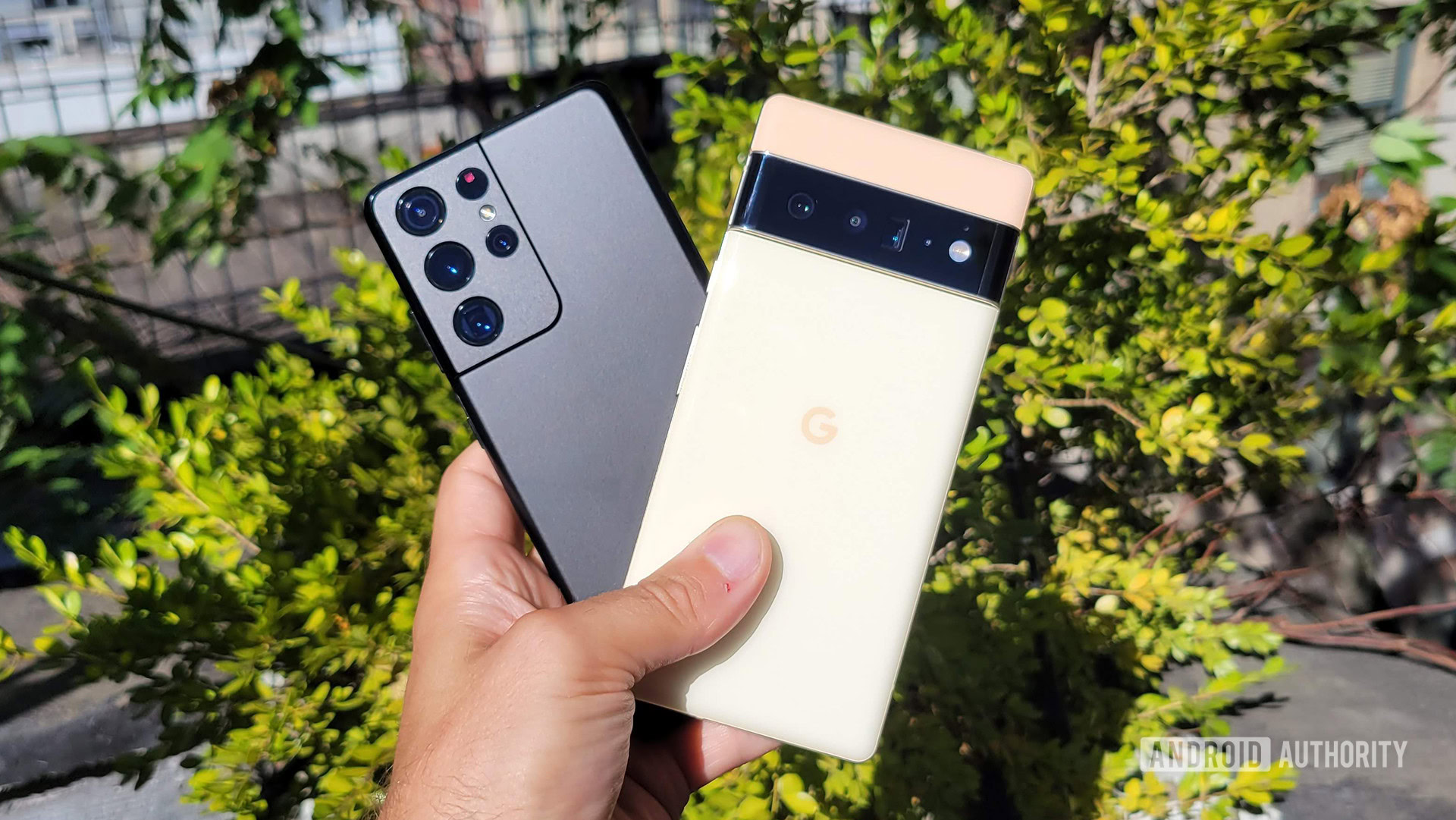
The Samsung Galaxy S21 series has been around since early 2021, and it has enjoyed plenty of time among the best Android phones on the market. Then, the competition got even steeper with the launch of the Pixel 6 and Pixel 6 Pro. You might be having a tough time deciding which device is best for you, but fear not. We’re here to help you decide in our Google Pixel 6 vs Samsung Galaxy S21 showdown.
We’ll take you through most of the critical elements, from the design to the price of each phone, before we ultimately deliver our verdict. Ready to grab a new phone? Let’s get started.
Our thoughts: Google Pixel 6 Pro review | Google Pixel 6 review
Google Pixel 6 vs Samsung Galaxy S21
Specs
| Google Pixel 6 | Google Pixel 6 Pro | Samsung Galaxy S21 | Samsung Galaxy S21 Plus | Samsung Galaxy S21 Ultra | |
|---|---|---|---|---|---|
Display | Google Pixel 6 6.4-inch OLED 20:9 aspect ratio FHD+ resolution 2,400 x 1,080 411ppi 90Hz refresh rate HDR support 24-bit depth Gorilla Glass Victus front Gorilla Glass 6 back | Google Pixel 6 Pro 6.7-inch OLED 19.5:9 aspect ratio QHD+ resolution 3,120 x 1,440 512ppi 120Hz adaptive refresh rate HDR support 24-bit depth Gorilla Glass Victus front and back | Samsung Galaxy S21 6.2-inch Dynamic AMOLED Flat FHD+ 2,400 x 1,080 at 421ppi Adaptive 120Hz refresh rate HDR10+ certified | Samsung Galaxy S21 Plus 6.7-inch Dynamic AMOLED Flat FHD+ 2,400 x 1,080 at 394ppi Adaptive 120Hz refresh rate HDR10+ certified | Samsung Galaxy S21 Ultra 6.8-inch Dynamic AMOLED Curved WQHD+ 3,200 x 1,440 at 515ppi Adaptive 120Hz refresh rate HDR10+ certified |
Processor | Google Pixel 6 Google Tensor Titan M2 security | Google Pixel 6 Pro Google Tensor Titan M2 security | Samsung Galaxy S21 Qualcomm Snapdragon 888 or Samsung Exynos 2100 | Samsung Galaxy S21 Plus Qualcomm Snapdragon 888 or Samsung Exynos 2100 | Samsung Galaxy S21 Ultra Qualcomm Snapdragon 888 or Samsung Exynos 2100 |
RAM | Google Pixel 6 8GB LPDDR5 | Google Pixel 6 Pro 12GB LPDDR5 | Samsung Galaxy S21 8GB | Samsung Galaxy S21 Plus 8GB | Samsung Galaxy S21 Ultra 12 or 16GB |
Internal storage | Google Pixel 6 128GB or 256GB UFS 3.1 | Google Pixel 6 Pro 128, 256, or 512GB UFS 3.1 | Samsung Galaxy S21 128 or 256GB | Samsung Galaxy S21 Plus 128 or 256GB | Samsung Galaxy S21 Ultra 128, 256, or 512GB |
Battery and power | Google Pixel 6 4,600mAh (typical) 30W wired charging USB-PD 3.0 (PPS) 21W wireless charging (w/ Pixel Stand) 12W Qi wireless charging Battery share No charger in box | Google Pixel 6 Pro 5,000mAh (typical) 30W wired charging USB-PD 3.0 (PPS) 23W wireless charging (w/ Pixel Stand) 12W Qi wireless charging Battery share No charger in box | Samsung Galaxy S21 4,000mAh Fast wired and wireless charging Reverse wireless charging | Samsung Galaxy S21 Plus 4,800mAh Fast wired and wireless charging Reverse wireless charging | Samsung Galaxy S21 Ultra 5,000mAh Fast wired and wireless charging Reverse wireless charging |
Cameras | Google Pixel 6 Rear: - 50MP main 1.2 μm, ƒ/1.85, 82-degree FoV 1/1.31-inch sensor LDAF, OIS, and EIS - 12MP ultra-wide 1.25 μm, ƒ/2.2, 114-degree FoV - Laser AF Front: - 8MP single 1.12 μm, ƒ/2.0, 84-degree FoV | Google Pixel 6 Pro Rear: - 50MP main 1.2 μm, ƒ/1.85, 82-degree FoV 1/1.31-inch sensor OIS and EIS - 12MP ultra-wide 1.25 μm, ƒ/2.2, 114-degree FoV - 48MP telephoto 0.8 μm, ƒ/3.5, 23.5-degree FoV 1/2-inch sensor 4x optical zoom OIS and EIS - Laser AF Front: - 11.1MP single 1.22 μm, ƒ/2.2, 94-degree FoV | Samsung Galaxy S21 Rear: - Wide-angle: 12MP, ƒ/1.8, 1.8µm with OIS and dual-pixel AF - Telephoto: 64MP, ƒ/2.0, 0.8µm with OIS and phase-detection AF - Ultra-wide: 12MP, ƒ/2.2, 1.4µm with 120-degree FoV 3x hybrid optical/digital zoom 30x "Space Zoom" Front: - 10MP, ƒ/2.2, 1.22µm, with dual-pixel AF | Samsung Galaxy S21 Plus Rear: - Wide-angle: 12MP, ƒ/1.8, 1.8µm with OIS and dual-pixel AF - Telephoto: 64MP, ƒ/2.0, 0.8µm with OIS and phase-detection AF - Ultra-wide: 12MP, ƒ/2.2, 1.4µm with 120-degree FoV 3x hybrid optical/digital zoom 30x "Space Zoom" Front: - 10MP, ƒ/2.2, 1.22µm, with dual-pixel AF | Samsung Galaxy S21 Ultra Rear: - Wide-angle: 108MP, ƒ/1.8, 0.8µm with OIS and phase-detection AF - Telephoto: 10MP, ƒ/2.4, 1.22µm with OIS, dual-pixel AF, and 3x optical zoom - Telephoto: 10MP, ƒ/4.9, 1.22µm with OIS, dual-pixel AF, and 10x optical zoom - Ultra-wide: 12MP, ƒ/2.2, 1.4µm with dual-pixel AF and a 120-degree FoV - Laser AF sensor 10x optical zoom 100x "Space Zoom" Front: - 40MP, ƒ/2.2, 0.7µm, with phase-detection AF |
Audio | Google Pixel 6 Stereo speakers Triple mics Bluetooth 5.2 No 3.5mm port | Google Pixel 6 Pro Stereo speakers Triple mics Bluetooth 5.2 No 3.5mm port | Samsung Galaxy S21 Stereo speakers Bluetooth 5.0 AKG tuning No 3.5mm port | Samsung Galaxy S21 Plus Stereo speakers Bluetooth 5.0 AKG tuning No 3.5mm port | Samsung Galaxy S21 Ultra Stereo speakers Bluetooth 5.2 AKG tuning No 3.5mm port |
Security | Google Pixel 6 In-display fingerprint Titan M2 chip 5 years security updates IP68-rated | Google Pixel 6 Pro In-display fingerprint Titan M2 chip 5 years security updates IP68-rated | Samsung Galaxy S21 In-display fingerprint 4 years security updates IP68 | Samsung Galaxy S21 Plus In-display fingerprint 4 years security updates IP68 | Samsung Galaxy S21 Ultra In-display fingerprint 4 years security updates IP68 |
Buttons and ports | Google Pixel 6 USB-C 3.1 Gen 1 Power button Volume rocker Dual SIM (single nano and eSIM) No expandable storage No 3.5mm port | Google Pixel 6 Pro USB-C 3.1 Gen 1 Power button Volume rocker Dual SIM (single nano and eSIM) No expandable storage No 3.5mm port | Samsung Galaxy S21 USB-C 3.2 Power button Volume rocker Dual SIM (single nano and eSIM) No expandable storage No 3.5mm port | Samsung Galaxy S21 Plus USB-C 3.2 Power button Volume rocker Dual SIM (single nano and eSIM) No expandable storage No 3.5mm port | Samsung Galaxy S21 Ultra USB-C 3.2 Power button Volume rocker Dual SIM (single nano and eSIM) No expandable storage No 3.5mm port |
Connectivity | Google Pixel 6 Wi-Fi 6E (802.11ax) Bluetooth 5.2 NFC support | Google Pixel 6 Pro Wi-Fi 6E (802.11ax) Bluetooth 5.2 NFC support UWB chip | Samsung Galaxy S21 Wi-Fi 6 Bluetooth 5.0 | Samsung Galaxy S21 Plus Wi-Fi 6 Bluetooth 5.0 | Samsung Galaxy S21 Ultra Wi-Fi 6E Bluetooth 5.2 |
Software | Google Pixel 6 Android 12 Pixel UI | Google Pixel 6 Pro Android 12 Pixel UI | Samsung Galaxy S21 Android 11 One UI 3.1 | Samsung Galaxy S21 Plus Android 11 One UI 3.1 | Samsung Galaxy S21 Ultra Android 11 One UI 3.1 |
Dimensions and weight | Google Pixel 6 158.6 x 74.8 x 8.9mm 207g | Google Pixel 6 Pro 163.9 x 75.9 x 8.9mm 210g | Samsung Galaxy S21 151.7 x 71.2 x 7.9mm 171g | Samsung Galaxy S21 Plus 161.5 x 75.6 x 7.8mm 202g | Samsung Galaxy S21 Ultra 165.1 x 75.6 x 8.9mm 229g |
Colors | Google Pixel 6 Stormy Black, Kinda Coral, Sorta Seafoam | Google Pixel 6 Pro Stormy Black, Cloudy White, Sorta Sunny | Samsung Galaxy S21 Phantom Violet, Phantom Gray, Phantom Pink, Phantom White | Samsung Galaxy S21 Plus Phantom Violet, Phantom Black, Phantom Silver | Samsung Galaxy S21 Ultra Phantom Black, Phantom Silver |
Design

Both the Pixel 6 and Galaxy S21 series take a similar approach to the display. You’ll find OLED panels across the board, as well as central punch-hole selfie cameras. Google and Samsung also reserved their sharpest Quad HD+ resolutions for the premium models — the Pixel 6 Pro and Galaxy S21 Ultra. The premium pair also sports curved displays, while the vanilla Google Pixel 6 and the Galaxy S21 and S21 Plus opt for flat panels.
Once you move around to the back of each phone, you really start to notice some changes. Samsung’s Galaxy S21 series sticks to a familiar corner cutout for the camera arrays as well as a satin finish. It’s far more resistant to fingerprints than Galaxy devices of years past, and the Phantom colors look great when the light hits them.
The Galaxy S21 features a less-premium glasstic back.
Samsung’s Galaxy S21 is the smallest of the bunch at 6.2-inches, while the Galaxy S21 Plus and the Galaxy S21 Ultra are nearly twins at 6.7-inches and 6.8-inches. You’ll also find that the Galaxy S21 features a “glasstic” back panel with a metal frame. Don’t worry, you can still tap into wireless charging, but you’ll have to splurge for the Galaxy S21 Plus or Ultra if you want a glass device.
Google’s Pixel 6 devices come with glass on the front and back. That does make for a glossier finish, but it’s worth the fingerprints to show off the return of Google’s two-toned designs. The Pixel 6 series also shares metal side rails, though you’re looking at matte black aluminum on the Pixel 6 compared to stainless steel on the Pixel 6 Pro.
Google’s more affordable device measures in with a 6.4-inch display, while the Pixel 6 Pro matches the Galaxy S21 Plus at 6.7-inches. However, the vanilla Pixel 6 caps off at a 90Hz refresh rate compared to 120Hz on the Pro.
Read our thoughts: Samsung Galaxy S21 review | Galaxy S21 Plus review | Galaxy S21 Ultra review
Of course, the camera bar is the feature you’re bound to notice above all else on the Pixel 6 series. It’s the first move away from a corner-mounted camera since the days of the Nexus 6P, as well as the dominant design element on Google’s new flagships. The camera bar is slightly higher on the Pixel 6 than the 6 Pro, but the lenses themselves make all the difference.
You won’t find a headphone jack on either the Samsung Galaxy S21 series or the Google Pixel 6 series, though both offer stereo speakers. As for buttons, both series offer a power button and a volume rocker, and that’s about it.
Cameras
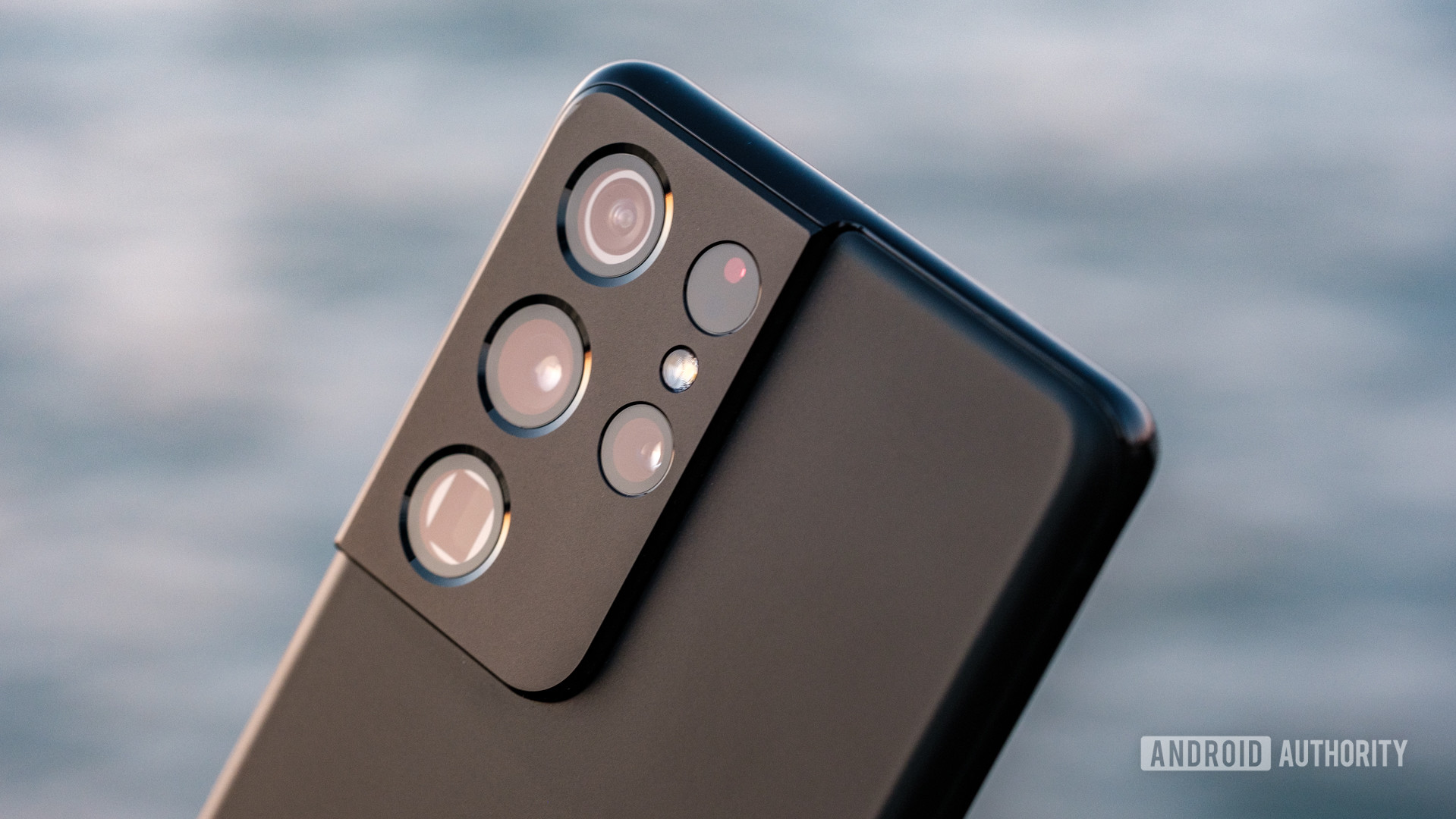
We teased the cameras briefly above, but now it’s time to get into the nitty-gritty. The Pixel 6 series offers Google’s largest camera leap since the Pixel 4 series added a second lens. The Pixel 6 and Pixel 6 Pro come with a 50MP primary lens and a 12MP ultrawide lens housed in the hefty camera bar. However, if you go for the Pixel 6 Pro, you’ll also get a 48MP telephoto lens to work with that’s capable of 4x optical zoom and up to 20x Super Res zoom.
See also: The best camera phones you can get
The Pixel 6 carries a fairly standard 8MP lens on the front, while the Pixel 6 Pro comes with an 11.1MP option. Ironically, the Pixel duo relies on Samsung’s GN1 camera sensors, which the Korean OEM hasn’t even used in its Galaxy S21 series.
On the other hand, Samsung left its cameras unchanged on the Galaxy S21 and the Galaxy S21 Plus. They offer 12MP wide lenses, 12MP ultrawide lenses, and 64MP telephoto lenses to round out the back panel, followed by 10MP selfie cameras on the front. Once again, the Galaxy S21 Ultra comes with Samsung’s very best. It trades the 12MP wide lens for a 108MP option and swaps the single telephoto lens for a 10MP telephoto and a 10MP periscope telephoto. Samsung’s fourth lens is a 12MP ultrawide shooter, and the 40MP selfie camera is by far the sharpest of the bunch.
Battery

Google hasn’t always packed the largest batteries into its Pixel devices. That was particularly a problem with the Pixel 4 and its much-maligned weak battery life. Now, those days seem to be in the past. We heaped praise on the Pixel 5a for its 4,680mAh battery as the largest in any Pixel to date, and now the Pixel 6 Pro has outdone it. Google’s premium flagship packs a 5,003mAh cell that’s now the largest in any Pixel.
The adoption of USB PD PPS makes the Pixel 6 series Google's fastest ever with 30W charging.
You can also make the most of 21W wired charging to regain up to 50% of your battery life in just 30 minutes. As for wireless charging, the Pixel 6 Pro supports up to 23W with the new Pixel stand. Over on the more affordable Pixel 6, you’ll find a 4,614mAh cell and up to 21W wireless charging. The 21W wired option is the same, and both phones rely on USB Power Delivery PPS for their fastest speeds.
Learn more: The Pixel 6 charges much slower than Google implied
Samsung’s trio uses the same USB PD PPS standard for charging, though only up to 25W speeds. You’ll also top out at 15W wireless charging speeds across all three models. The Galaxy S21 packs the smallest cell at 4,000mAh, while the Galaxy S21 Plus and S21 Ultra are nearly equal at 4,800mAh and 5,000mAh, respectively.
Colors
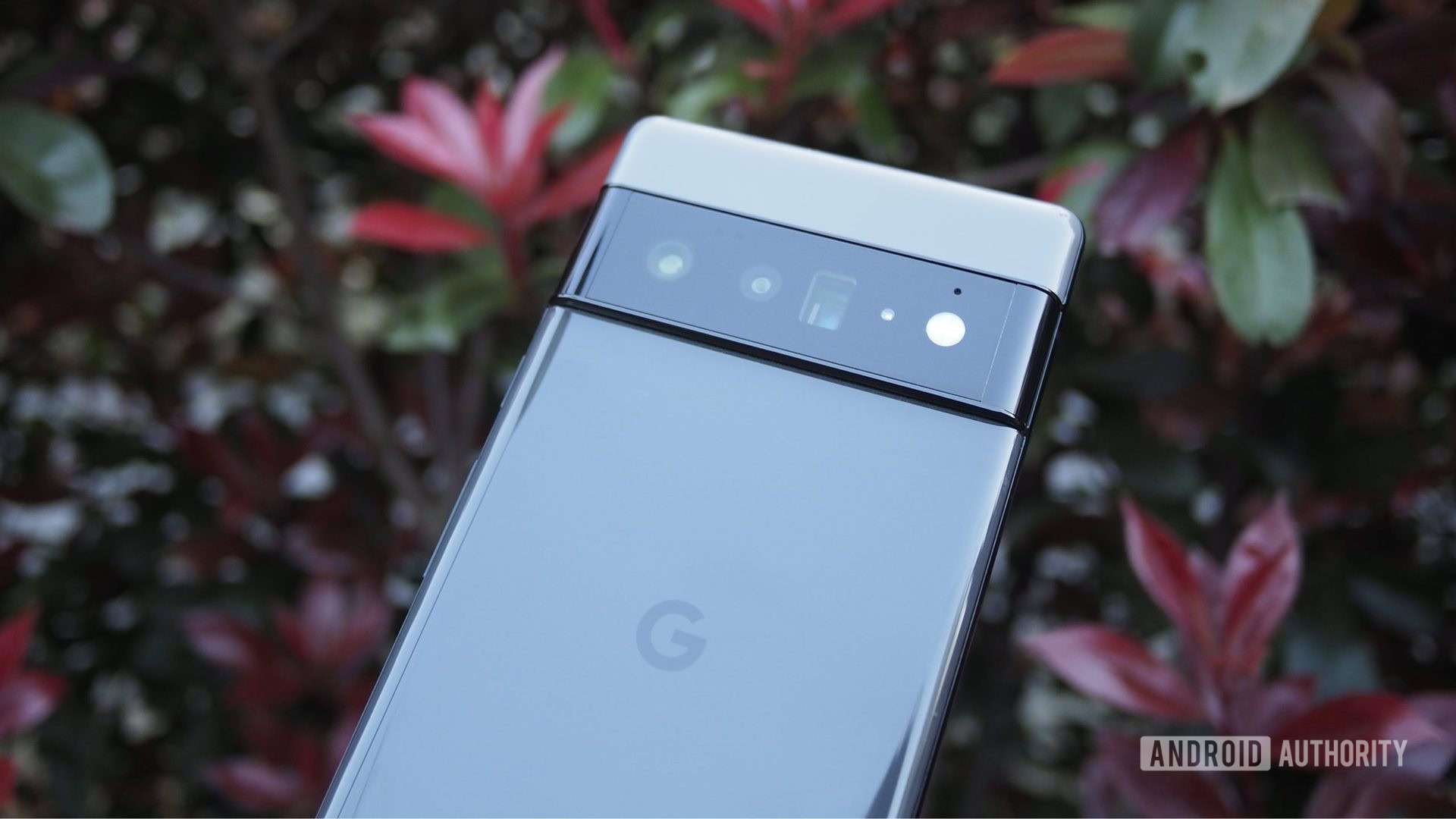
Samsung’s Phantom colorways for the Galaxy S21 series are some of its best in years. The Phantom Violet, as seen above, sports a violet back panel with a rose gold camera housing that’s unlike Samsung’s usual approach. It also comes in Phantom Pink, which swaps violet for pink and hangs onto the rose gold.
Each version of Samsung’s 2021 flagship comes with the same satin finish, which should be good to keep fingerprints at bay. If you’re not looking for as bright of a color, Samsung also offers Phantom Black, Phantom Silver, Phantom Gray, and Phantom White. There are a few Samsung-exclusive colorways for the premium Galaxy S21 Ultra, such as Phantom Navy and Phantom Brown.
The Pixel 6 series has a two-tone finish that adds a bit of contrast to the devices.
Over on the Pixel side, Google has finally resurrected its two-tone finishes. The options differ between the Pixel 6 and the Pixel 6 Pro, with the vanilla model coming in Kinda Coral, Sorta Seafoam, and Stormy Black. If you go for the more expensive Pixel 6 Pro, you can choose from Cloudy White, Sorta Sunny, and Stormy Black.
Kinda Coral blends a pink body with a slightly red section above the camera bar, while Sorta Seafoam offers a green and yellow finish. Stormy Black comes with a combo of black and gray across both models, with Sorta Sunny and Cloudy White filling in as gold and silver options.
Opinion: The Pixel 6 design is amazing, actually
Price
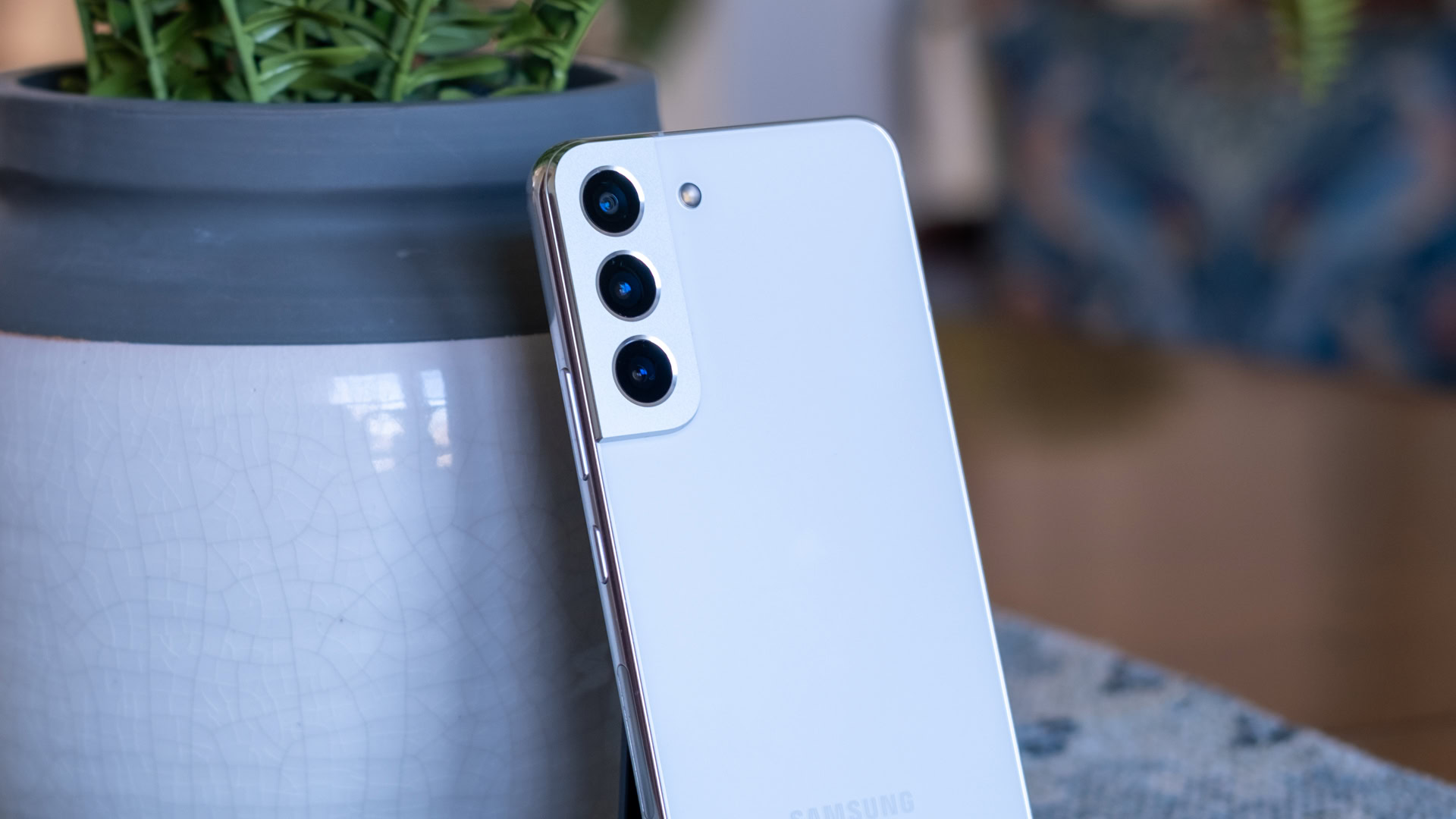
- Samsung Galaxy S21: $799 / £769 / €849
- Samsung Galaxy S21 Plus: $999 / £949 / €1,049
- Samsung Galaxy S21 Ultra: $1,199 / £1,149 / €1,249
- Google Pixel 6: $599 / £599 / €649
- Google Pixel 6 Pro: $899 / £849 / €849
Both the Samsung Galaxy S21 series and the Google Pixel 6 series represent a return to lower prices in 2021. The entire Galaxy S21 range received a $100 price cut compared to the previous Galaxy S20 lineup. Samsung’s most affordable Galaxy S21 kicks off at $799 — right in line with the vanilla iPhone 13. Each model jumps by $200 from there, giving the S21 Plus a $999 starting point and the S21 Ultra a $1,199 price tag.
However, those prices are for the 128GB Galaxy S21, S21 Plus, and S21 Ultra. Raising your storage to 256GB will cost an extra $50 on average, or you can go up to 512GB on the Galaxy S21 Ultra for $1,379.
The Samsung Galaxy S21 series has become harder to find since the launch of the Galaxy S22 series. However, it may be beneficial to opt for the newer flagship, as it packs upgraded internals at the same asking price. The Galaxy S22 Ultra has even taken over as a Galaxy Note alternative.
Save some money: The best Pixel deals | The best Samsung Galaxy deals
While Samsung went for a slightly more affordable approach, the standard Pixel 6 now costs $599. It comes with 128GB of storage on board, or you can get the 256GB version for $699. Google’s Pixel 6 Pro launched at $899 for 128GB, $999 for 256GB, or $1,099 for the maximum 512GB version.
Check out our widgets below if you’re ready to make your decision:

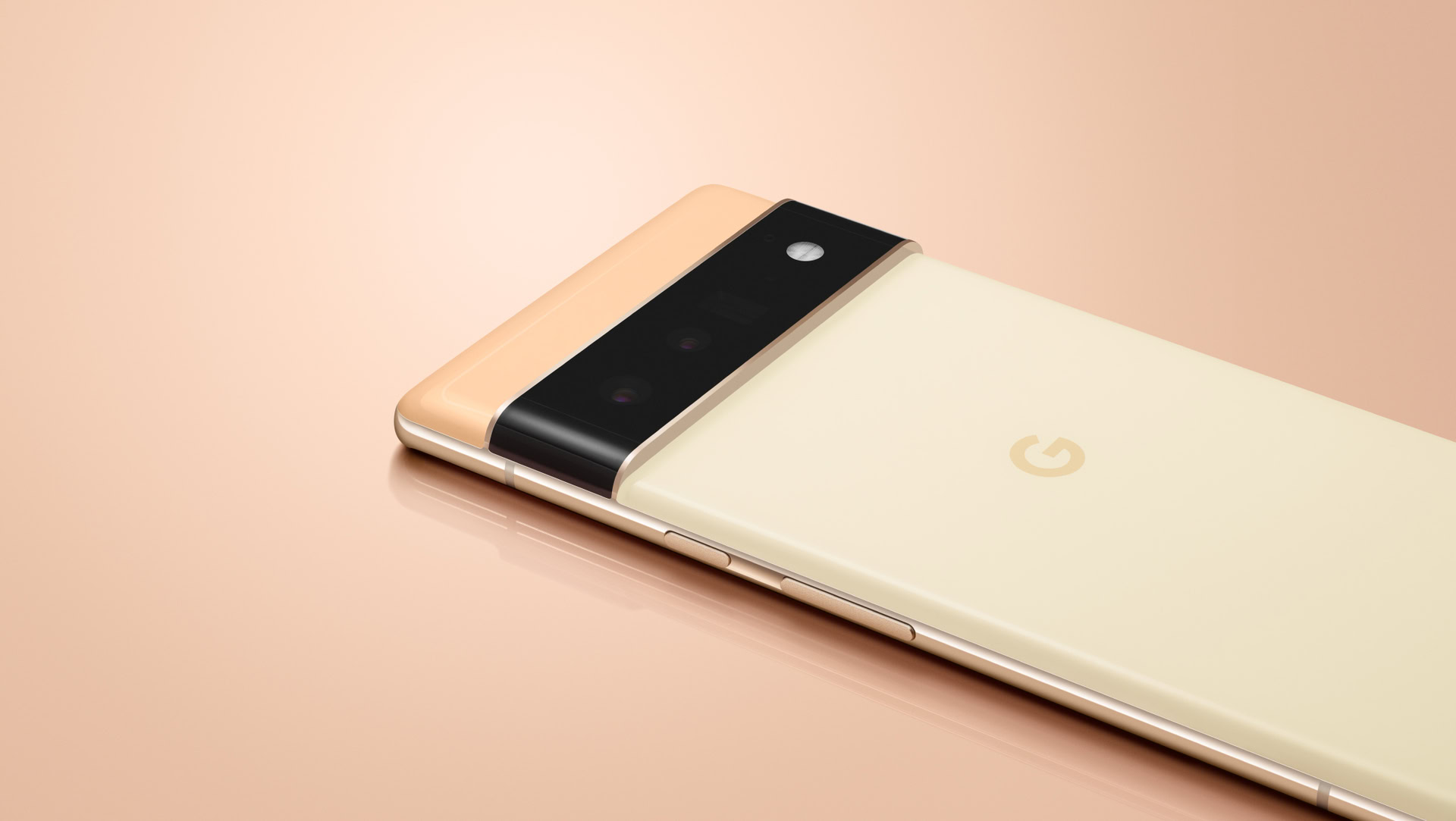
Google Pixel 6 vs Samsung Galaxy S21: Which should you buy?
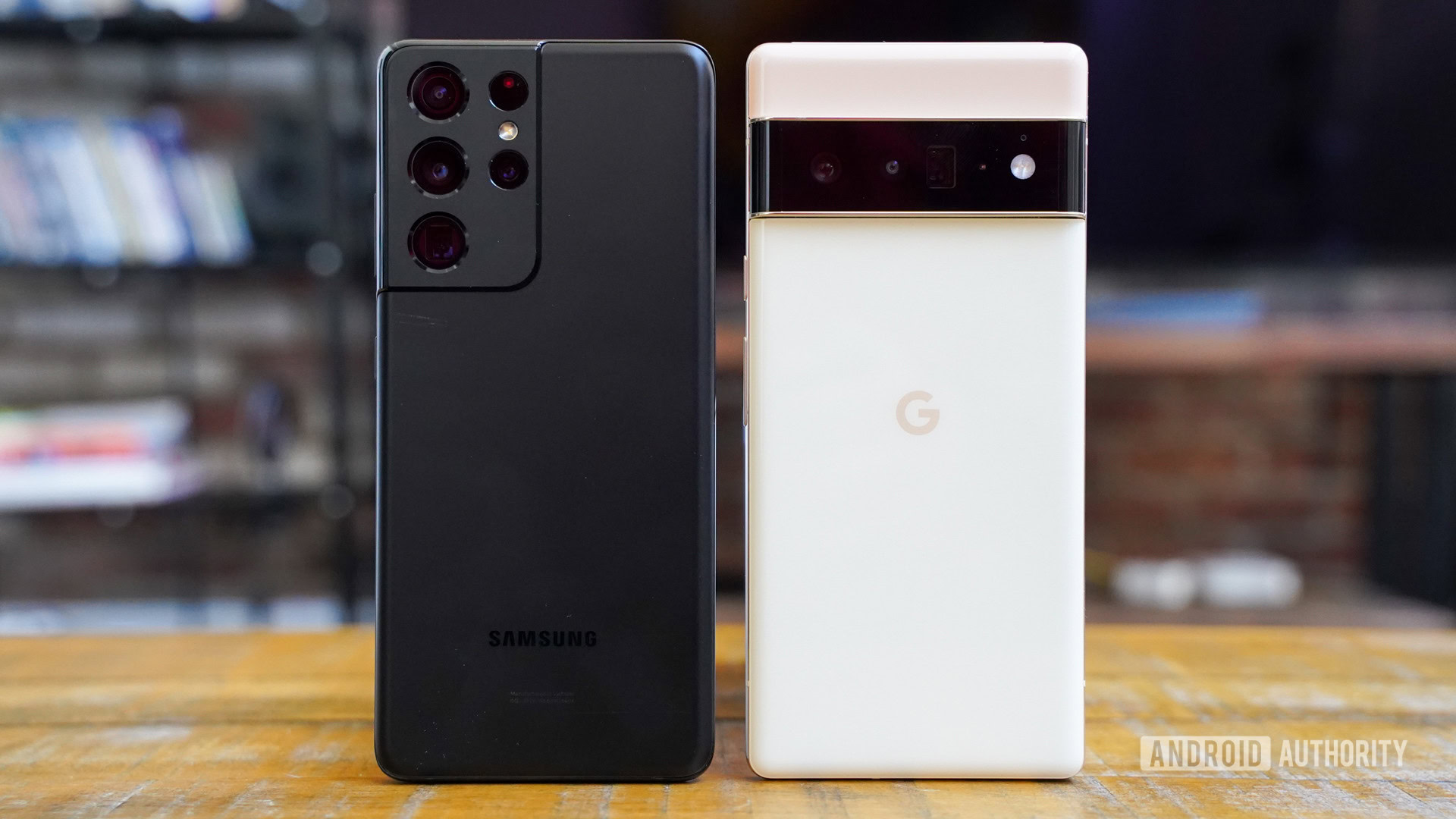
Now we’ve reached the most complicated question of all: which phone should you actually buy? Well, it’s tough to say. Google’s pricing is more competitive, and the Pixel 6 series finally offers some serious upgrades in the camera department. But the Galaxy S21 series offers more in other areas, so it depends on which features you value more.
Learn more: Which Samsung Galaxy S21 phone is right for you?
Both series are tried and true flagships, and it’s hard to go wrong with either one. If you want to save the most money, go for the Pixel 6. If you want the best Android experience around, it just might be a toss-up between the Pixel 6 Pro and the Galaxy S21 Ultra. You’ll have to decide whether you want Qualcomm’s Snapdragon 888 processor in the Galaxy S21 series or the brand-new Google Tensor chip that the Pixel 6 series packs under the hood.
The Pixel phones come with less bloatware.
Then there’s the software. The Pixel phones run a clean yet Google-ified version of Android, while Galaxy S21 handsets have Samsung’s One UI on board. Both have their pros and cons, with one of the most significant differences being that you get less bloatware with Google’s flagships. The software of the Pixel phones is a bit less feature-packed, but it’s also a lot cleaner at the same time.
Both the Pixel and Galaxy devices will get three major OS updates, but keep in mind that the Pixel 6 series launched with Android 12 onboard, while the Galaxy S21 phones launched with Android 11. That means the Pixels will get Android 13, 14, and 15, while the road for the Galaxies will end with Android 14. The Pixel 6 series also pushes security updates to four years over the three years you get with Samsung’s phones.
How are they holding up? Google Pixel 6 Pro revisit | Samsung Galaxy S21 Ultra revisit
Made up your mind? Let us know which one you think comes out on top in the Google Pixel 6 vs Samsung Galaxy S21 battle below.